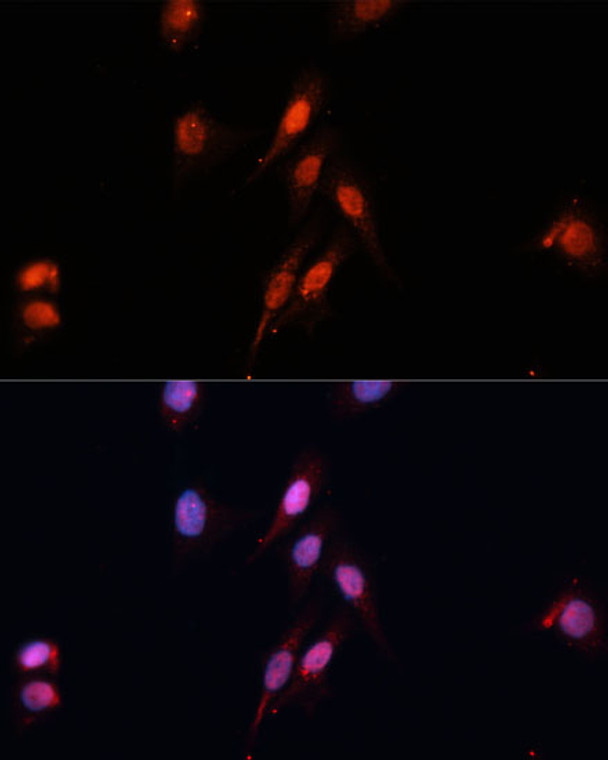| Host: |
Rabbit |
| Applications: |
WB/IHC/IF |
| Reactivity: |
Human/Mouse/Rat |
| Note: |
STRICTLY FOR FURTHER SCIENTIFIC RESEARCH USE ONLY (RUO). MUST NOT TO BE USED IN DIAGNOSTIC OR THERAPEUTIC APPLICATIONS. |
| Short Description: |
Rabbit polyclonal antibody anti-Smad5 (200-300) is suitable for use in Western Blot, Immunohistochemistry and Immunofluorescence research applications. |
| Clonality: |
Polyclonal |
| Conjugation: |
Unconjugated |
| Isotype: |
IgG |
| Formulation: |
PBS with 0.01% Thimerosal, 50% Glycerol, pH7.3. |
| Purification: |
Affinity purification |
| Dilution Range: |
WB 1:500-1:2000IHC-P 1:50-1:200IF/ICC 1:50-1:200 |
| Storage Instruction: |
Store at-20°C for up to 1 year from the date of receipt, and avoid repeat freeze-thaw cycles. |
| Gene Symbol: |
SMAD5 |
| Gene ID: |
4090 |
| Uniprot ID: |
SMAD5_HUMAN |
| Immunogen Region: |
200-300 |
| Immunogen: |
A synthetic peptide corresponding to a sequence within amino acids 200-300 of human Smad5 (NP_005894.3). |
| Immunogen Sequence: |
STYPNSPASSGPGSPFQLPA DTPPPAYMPPDDQMGQDNSQ PMDTSNNMIPQIMPSISSRD VQPVAYEEPKHWCSIVYYEL NNRVGEAFHASSTSVLVDGF T |
| Tissue Specificity | Ubiquitous. |
| Post Translational Modifications | Phosphorylated on serine by BMP (bone morphogenetic proteins) type 1 receptor kinase. Ubiquitin-mediated proteolysis by SMAD-specific E3 ubiquitin ligase SMURF1. |
| Function | Transcriptional regulator that plays a role in various cellular processes including embryonic development, cell differentiation, angiogenesis and tissue homeostasis. Upon BMP ligand binding to their receptors at the cell surface, is phosphorylated by activated type I BMP receptors (BMPRIs) and associates with SMAD4 to form an heteromeric complex which translocates into the nucleus acting as transcription factor. In turn, the hetero-trimeric complex recognizes cis-regulatory elements containing Smad Binding Elements (SBEs) to modulate the outcome of the signaling network. Non-phosphorylated SMAD5 has a cytoplasmic role in energy metabolism regulation by promoting mitochondrial respiration and glycolysis in response to cytoplasmic pH changes. Mechanistically, interacts with hexokinase 1/HK1 and thereby accelerates glycolysis. |
| Protein Name | Mothers Against Decapentaplegic Homolog 5Mad Homolog 5Mothers Against Dpp Homolog 5Jv5-1Smad Family Member 5Smad 5Smad5Hsmad5 |
| Database Links | Reactome: R-HSA-201451 |
| Cellular Localisation | CytoplasmNucleusMitochondrionCytoplasmic In The Absence Of LigandMigrates To The Nucleus When Complexed With Smad4 |
| Alternative Antibody Names | Anti-Mothers Against Decapentaplegic Homolog 5 antibodyAnti-Mad Homolog 5 antibodyAnti-Mothers Against Dpp Homolog 5 antibodyAnti-Jv5-1 antibodyAnti-Smad Family Member 5 antibodyAnti-Smad 5 antibodyAnti-Smad5 antibodyAnti-Hsmad5 antibodyAnti-SMAD5 antibodyAnti-MADH5 antibody |
Information sourced from Uniprot.org
12 months for antibodies. 6 months for ELISA Kits. Please see website T&Cs for further guidance










